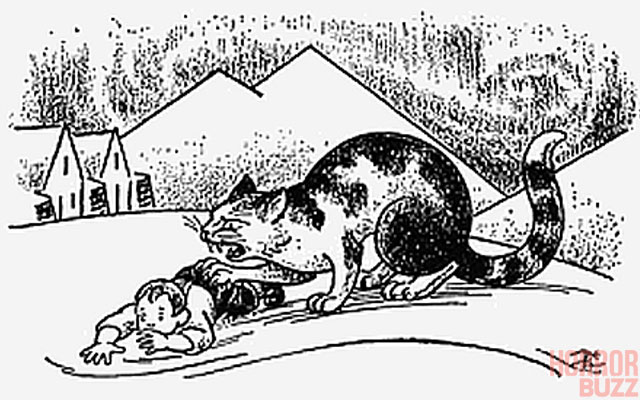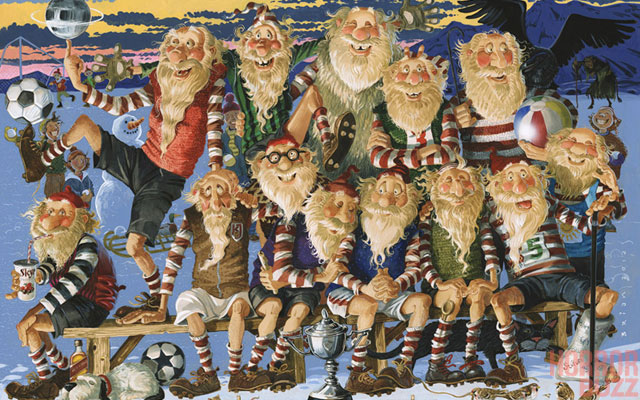‘Tis the season to be jolly. It’s also the season to try and hold on to as much horror as you can until the new year officially cements the departure of Halloween. This sentiment is not really a new one as cultures from around the globe have had plenty of things to be scared about during the holiday season. Sure, we have all heard about the Krampus. But have you heard of the GRÝLA? What about Mari Lwyd the zombie horse? Clearly there is a lot more to be fearful of. Here is a list of 13 Christmas monsters that simply don’t get enough recognition.
GRYLA

The painting of Gryla by Þrándur Þórarinsson, 2009.
Oh this one is delicious. The legendary Grýla is from Iceland, home of Bjork. As the story goes, she had three different husbands and 72 children, all who caused trouble ranging from harmless mischief to murder. Predating the Yule Lads in Icelandic legend, this devilish monster kidnaps, cooks up, and eats naughty, disobedient children. Truth be told she didn’t start out a Christmas monster, per se, until about the 17th century when she was associated as the mother to the Yule Lads.
THE YULE LADS
Following Ms. Gryla, are her thirteen the Yule Lads. Each are known for a particular habit or characteristic ala the seven dwarves. Instead of Sleepy, Bashful, Dopey, Doc, or Grumpy, we get less lyrical names like “Gully Hawk”, “Pot Scraper”, and our favorite, “Window Peeper”. Children are said to be visited each night on the thirteen days leading up to Christmas by a different Yule Lad each night. The visitors include…
“Sheep Cote Clog” a peg-legged sheep “fancier”.
“Gully Hawk” This guy hides out in ditches and waits for an opportune moment to run into the cow shed and lick the foam off the milk in the milking buckets. Oddly specific threat if you ask us.
“Stubby” He’s the short one.
“Spoon Licker” Guess what this one does.
“Pot Scraper” a thief of leftovers.
“Bowl Licker” hides under your bed and waits for you to absentmindedly put down your bowl so he can steal it.
“Door Slammer” No, it’s not the wind. It’s this little bugger who slams doors all night.
“Skyr(Yogurt) Gobbler” A relentless consumer of the tart, dairy treat.
“Sausage Swiper” Our second favorite lad, this one steals sausage.
“Window Peeper” This one watches you from the windows.
“Doorway Sniffer” Weird, right? This guy uses his incredibly large nose to sniff through doors to find bread. So it’s not as much about smelling a door as it is finding food.
“Meat Hook” A hook madden lad who snags meat,
“Candle Stealer” Yep. It’s exactly what you think it is.
FRAU PERCHTA
Frau Percha (Mrs. Bertha) aka The Bright One, is known to visit the children of Austria and Germany, handing out both rewards and punishments during the 12 days of Christmas (December 25-January 6). Good kids get gifts. Bad kids get a gruesome punishment; she will rip out your internal organs and replace them with garbage!
Perch’s legend and storyline are believed to have developed from a legendary Alpine goddess of nature, who tends the forest most of the year and deals with humans only during Christmas. Nowadays, Perchta shows up in parades and processions during Fastnacht, the Alpine festival just before Lent.
STRAGGELE
In many places Frau Perchta rides with a gang of demonic helpers known as Straggle . These creatures feast on the offerings left out for them on Christmas by revelers hoping for Frau Perchta’s blessings in the new year. It is said that sometimes the Straggele get to dish out the punishments themselves, robbing all bad children and tearing some of them to pieces.
JÓLAKÖTTURINN the Yule Cat

Let’s say hi to Jólakötturinn, the Icelandic Yule Cat. Otherwise known as The Christmas Cat, Jólakötturinn is the evil pet cat of Gryla. As the common belief goes in many Icelandic families, people who finished their work and chores on time receive new clothes for Christmas. The lazy did not and are forced to wear the same tattered rags. Parents told the tale of the Yule Cat, saying that Jólakötturinn could tell who the lazy children were because they did not have at the very least one new item of clothing. Old-clothes wearing fools would be sacrificed to the Yule Cat. Catty.
BELSNICKEL
In many German and Pennsylvannia Dutch communities, Belsnickel shows up a few weeks before Christmas to beat the children who have misbehaved. Filthy and dressed in rags and furs this brute has a face of black, a bell, a whip, and a pocket full of cakes or nuts. Depending on whether you were good or bad you either ended up with cake or some form of punishment. It was popular in the 19th century to go out partying or “Belsnicking” and get drunk, vandalize the city, and play pranks.
THE TOMTEN
The Tomten is a monster from Scandinavian folklore who bears a resemblance to a little gnome and lives among the dead inside burial mounds. He acts as a caretaker, protector, and helper of the household. When angered The Tomten has quite the temper. He is known for driving people crazy with his tricks or biting them. What’s worse is that one bite from the poisonous mouth of The Tomten could lead to death. Customarily people from this region leave goodies out for him to appease his volatile mood.
LE PÈRE FOUETTARD
French-speaking countries call Santa Claus St. Nicholas or Père Noël (Father Christmas). But in those same regions good ol’ St. Nick has a sinister opposite in Père Fouettard (Father Whipper or Father Spanker). Fouettard is a scraggly, wild man who beats unruly children on St. Nicholas’ Day. He is, most of the time, depicted wearing a long, black beard and hooded robe, carrying a whip or a handful of birch rods.
According to legend, Père Fouettard was an unscrupulous innkeeper who murdered three young children and planned to carve up their corpses to sell as meat. Shades of Sweeny Todd for sure. His plan was undone by St. Nicholas, who resurrected the children and forced Père Fouettard to become his minion. It makes perfect sense. Rehabilitate the child murderer by making him punish children.
KNECHT RUPRECHT
A man on Christmas Eve to enters the home, disguised with a long beard, and enveloped either in fur or in pea-straw, and asks children whether they can pray. If the children pass the test, Ruprecht rewards them with apples, nuts and gingerbread. If the children don’t make the cut, they are severely punished. He carries a long staff and a bag of ashes with which he beats the reprobate children who haven’t learned to pray.
MARI LWYD – THE CHRISTMAS ZOMBIE HORSE
A horse is a horse of course of course and no one can talk to a horse of course. That is, of course, unless the horse is the famous Mr. Dead. Mari Lwyd rises from the grave on New Years Eve to challenge the living in a battle of wits. This macabre skeleton-mare hales from Welsh folk lore. She rises from the dead and wanders the streets with her attendants, also fresh from the grave, to remind the living of their existence. The ol’ great mare has only one goal in mind which is getting into your house. In order to keep the zombie horse out, one must engage in a rhyming battle of wits. This undead mare is usually represented by a puppeteer parading a horse skull on a pole draped in white cloth. Weirder things have happened aside from rapping in Welsh dialect with a horse head on New Years. Just sayin’.
LA BEFANA or BABOUSHKA
All over Russia, Italy and sections of Eastern Europe, there is a story of a witch lady rooted in the fairy tale figure of Mother Holle who dishes out punishments for the lazy, and riches for the hard working. To the Italians she is called La Befana. In Russia they refer to her as Baboushka. Every January, she packs up and sets off on a broomstick to join the three kings who are also seeking the Christ Child. She searches every house and if she finds a child there, she leaves gifts. Not really a scary monster in as much as it is a regional creature that comes to life around the holidays.
HANS TRAPP

Hans Trapp is another wonderful character that executes punishment on the bad children in the Alsace and Lorraine regions of France. As the legend goes, Trapp was a real, very rich, very greedy, very evil man. A worshipper of Satan himself. Trapp was excommunicated from the Catholic Church and exiled into the forest where he preyed upon children, disguised as a scarecrow. Originally a “living” evil doer, the story says that when he was about to eat one boy, God finally punished him by striking him with a deadly dose of lightening. His ghost now visits young children before Christmas, dressed as a scarecrow, to terrify them into good behavior.
THE GRINCH
The Grinch is not a monster created from folklore or years of cultural legend. He is a fictional character created by Dr. Seuss. He first appeared as the main character of the 1957 Christmas story How the Grinch Stole Christmas!
The grumpy, anti-holiday spirit of the character has led to the term “Grinch”, surpassing even the term “Scrooge” in current, popular lexicon. Derived from the French word grinches, “grumpy”, a “Grinch has come to mean a person opposed to Christmas celebrations. The difference here is that the Grinch is a cautionary tale with a happy outcome in which the monster is won over by the Christmas spirit.
There you have it. As you can see, Mr. Krampus isn’t the only holiday monster to meddle in the lives of yule fools. Are there any traditions or legends that we missed? What are some of your family superstitions, creations, or stories that have been passed down to you? Tell us about them in the comments below!







![THE FIELD Delivers an Atmospheric Haunting [REVIEW]](https://horrorbuzz.com/wp-content/uploads/2019/10/The-Field-500x383.jpg)


